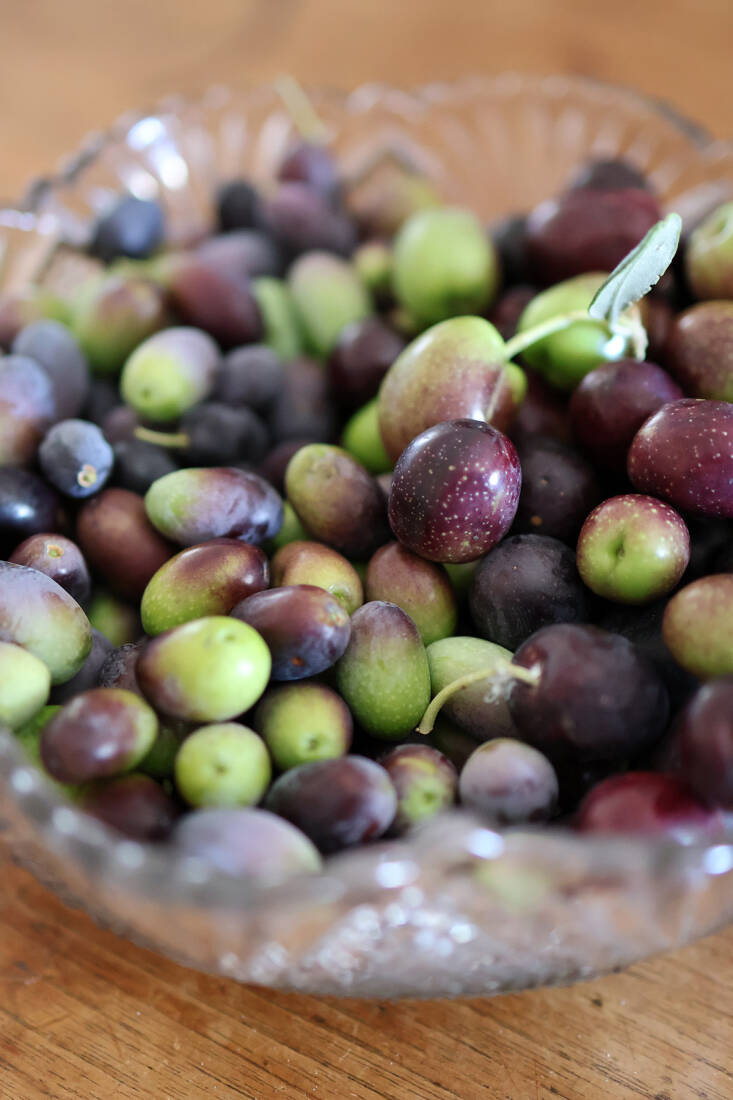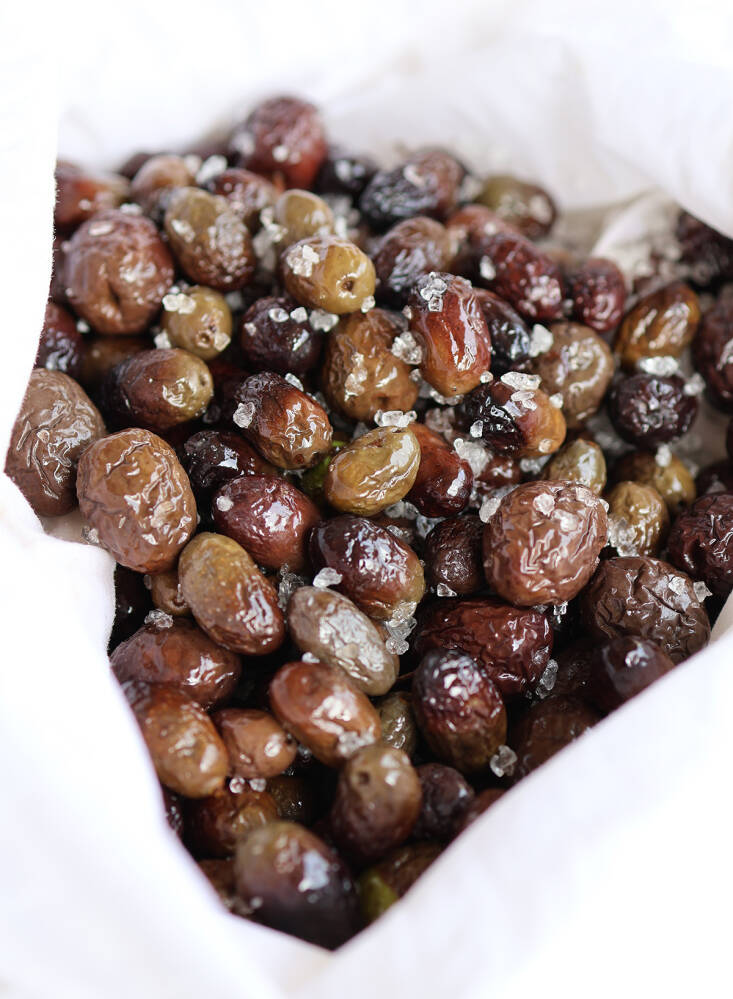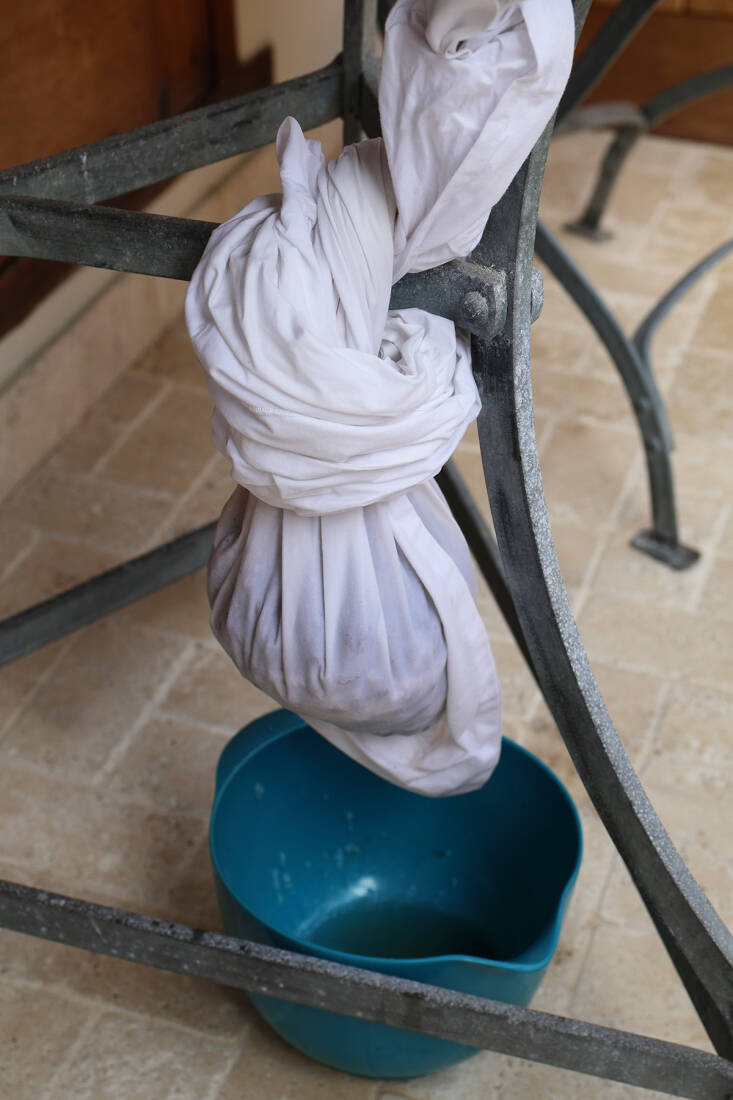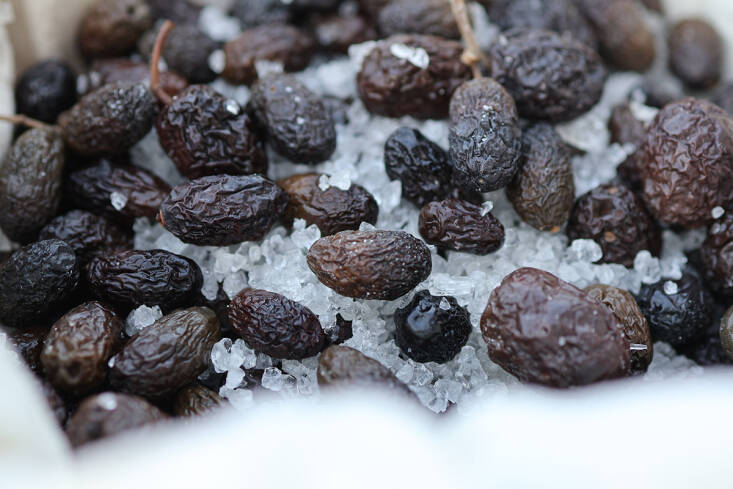As autumn whispers into our days and nights, olives, somewhere, are ripening. And that makes my mouth water in anticipation. Oil-cured olives await. My olive-curing adventures began this cold January, when I was gifted a tiny, fresh crop of ripe black olives by Rachel Prince, a talented professional gardener and friend who lives two blocks west of us in Brooklyn. Rachel grows her three-foot tall Arbequina olive trees in pots that overwinter indoors in our USDA growing zone 7b (-ish). I had always wanted to make oil-cured—versus brined—olives, whose meaty, concentrated flavor can be addictively good, for anyone who loves savory flavors. The results, a couple of weeks later, were surprisingly delicious, and the process could not have been easier.
All you need to make oil-cured olives are salt, olives, and time. And maybe a pillow slip.
Above: Tiny, Brooklyn-grown olives, ready after two weeks in salt.
As I read about how to make oil-cured olives (starting with this delightful tutorial) I learned quickly that the term “oil cured” is a misnomer—no oil is involved in the curing process. It’s more accurate to describe these wizened treats as dry-cured, or salt-cured. But the description seems to stick.
Rachel’s little cold-bletted olives were less bitter than most, but I still soaked them overnight, then mixed them with an equal weight of sea salt before hanging them in a cloth from the ceiling (right beside the annual hoshigaki), to cure. Snow fell on the skylight above. After a week, I tasted one. Still mildly bitter. But just one week more and the tiny olives were ready. I was delighted to discover that they tasted—at least to me—exactly as oil-cured olives should: savory and succulent, in a wrinkled way.
 Above: Olives in April outside Nieuwoudtville, South Africa.
Above: Olives in April outside Nieuwoudtville, South Africa.
A few months later, in April and a hemisphere away, I found myself outside Nieuwoudtville, South Africa, standing awed beside three 12-foot olive trees whose silver-leafed branches were weighed down with plump green and black fruit. They were planted around our accommodations, a 200-year-old farmstead that was our base for a once-in-a-lifetime trip to see the annual and breathtaking autumn display of Brunsvigia flowers in the veld around the town. Pomegranate trees grew beside the olives, their ripe-to-bursting fruit splitting to expose juicy red gems. Rosemary in bloom clambered over a stone wall. In a word, heaven.
I remembered those dead-easy oil-cured olives in wintery Brooklyn, and I began to pick.
 Above: My oil-cured olives with orange, shatta, and mint.
Above: My oil-cured olives with orange, shatta, and mint.
Oil-cured olives recall two formative meals. One, where, as an impressionable 20-year old waiting for a waiter-friend to finish his shift in a Turkish restaurant in Cape Town, I found myself the surprised recipient of two plates, sent from the kitchen to me by the intimidating chef. On a small plate was a slab of unadorned sheeps’ milk feta. The second plate contained nothing but glossy, oil-cured olives. I had never seen any before. A diminutive carafe of red wine arrived. It seemed shockingly austere, and I have never forgotten it (the chef went on to become a friend and food mentor; now 85, he lives in Istanbul).
The other indelible memory is from Café Gitane, an indefatigable restaurant in Manhattan’s Nolita, where, ten years after that light night snack, I ate for lunch a startling salad of orange segments, oil-cured olives, and chile. It was served with a hunk of baguette, whose purpose was to sop up the complicated-tasting and soupy juice at the bottom of the bowl. I have made that salad ever since, recently with shatta as well as some mint, from our little terrace. The addition of house-cured olives makes it an even more satisfying pleasure.
 Above: The Nieuwoudtville bowl of mixed-variety fresh olives, on April 11th.
Above: The Nieuwoudtville bowl of mixed-variety fresh olives, on April 11th.
Those plump Niewoudtville olives travelled. First, back to our Cape Town base, where I hung them in a pillow slip from an iron café table on the little terrace where we were staying. Then back to New York, in a ziplock, salt and all. At home, in Brooklyn, they were switched to a cotton kitchen cloth and hung for another week until no more moisture could be detected. On the 29th day of their cure, finding that they tasted wonderful, I rinsed them, let them dry, and then packed them in jars with—finally!—a tablespoon of olive oil to gloss them up. I ate one a few moments before writing these words, and they are as delicious as ever. Bold, succulent, slightly chewy, and umami-ly compelling.
 Above: The olives in Cape Town on April 22nd, after 10 days in salt.
Above: The olives in Cape Town on April 22nd, after 10 days in salt.
 Above: An improvised curing station—a pillowslip, a table, and a bowl to catch the olives’ bitter juices.
Above: An improvised curing station—a pillowslip, a table, and a bowl to catch the olives’ bitter juices.
 Above: On May 10th, after 29 days, the olives tasted ready, in Brooklyn.
Above: On May 10th, after 29 days, the olives tasted ready, in Brooklyn.
All you need to make oil cured olives are fresh olives, salt, and a cotton cloth (or pillow slip*) large enough to contain them. If you have a scale, you weigh the olives and weigh out an equal amount of salt. If you don’t have a scale, you eyeball the amount, as I did that second time, in that old Cape Dutch homestead’s kitchen whose walls were two feet thick.
* If you’re worrying about the pillow slip: an overnight soak in cold water followed a wash removes all trace of olive juice. Like it never happened.

Oil-Cured Olives
I have used both ripe black and unripe green olives—the green olives will turn dark brown to black over time, in the salt. Large olives will take longer to cure, little ones will be quite quick. You have to taste them. Over weeks they transform from inedibly bitter to delicious. You could also skip the cloth and the hanging and simply layer them in a large jar (covered loosely) with an equal weight of salt. Pour off any accumulated juice daily.
- Fresh olives
- Equal weight of sea salt (either fine or large crystals)
- A clean cotton cloth or pillow slip
- Extra virgin olive oil (to finish)
Wash the olives and set them to soak overnight in a large bowl of water. Drain and dry them. Transfer to a bowl and add their weight in salt. Toss to mix. Place the olives with the salt in the center of a large clean cloth, gather the corners and tie the cloth up to hang from the ceiling, or beneath a table, or a tree, or a clothes’ drying rack—anywhere where they can remain for about two to four weeks. Place bowl beneath them to catch any drops of moisture. Taste the olives weekly to appreciate their development of flavor and reduction of bitterness.
When the olives taste good, they are ready. Rinse them, air dry them, and pack them into clean jars. Add 1 to 2 tablespoons of extra virgin olive oil, toss to coat, and store at room temperature.
Olive Acquistions
Well-established trees can be bought online from Four Winds Growers: A 36 to 48-inch Arbequina is $65.
In season, fresh, organic, ripe olives from Handy Farms: (1lb minimum is $17)
Fresh green olives from American Olive Farmer: (10lb minimum is $50)



